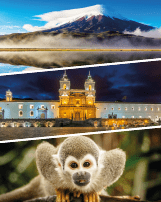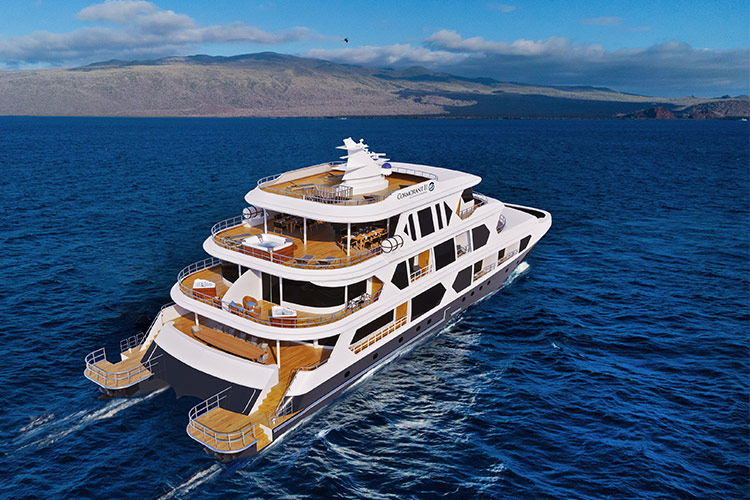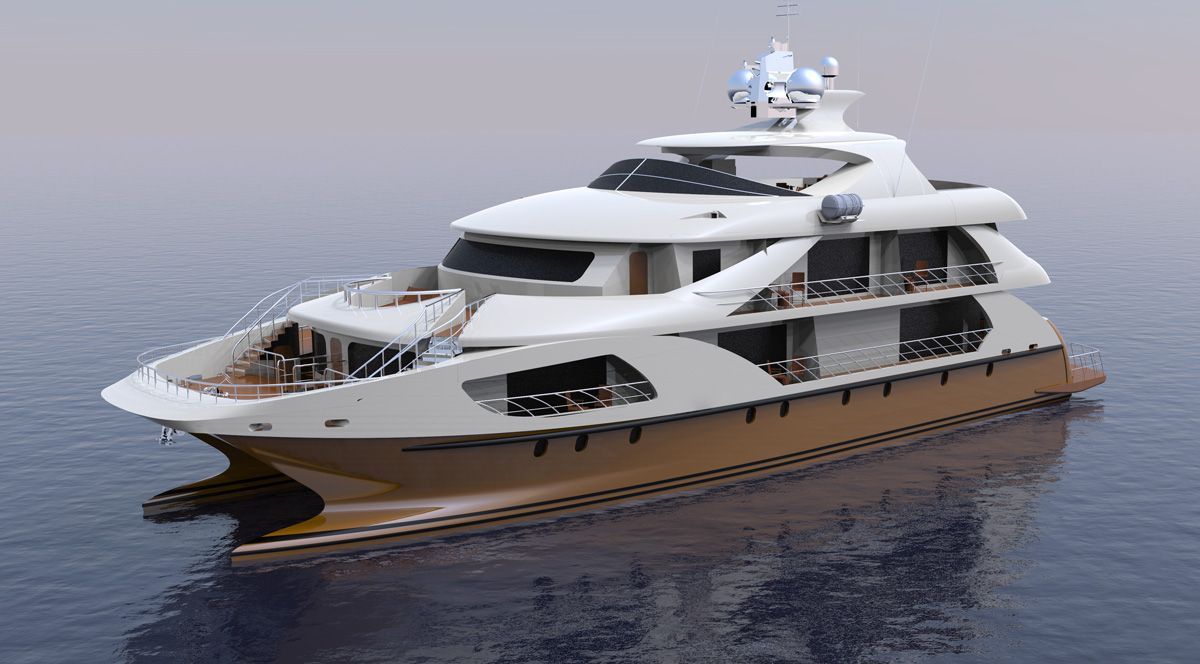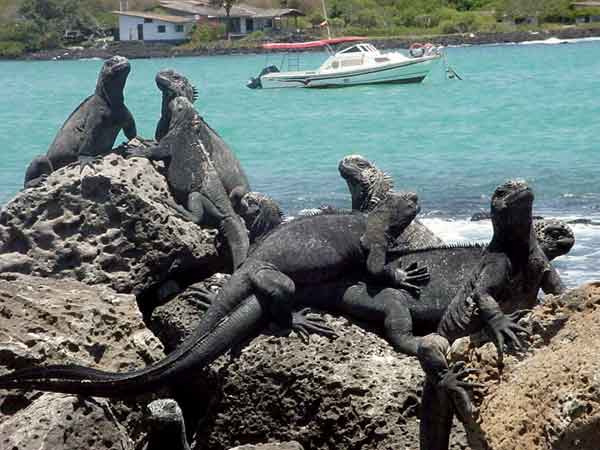Cruises
The Golondrina cruise invites you to discover the Galapagos Islands.
The Golondrina is a spacious and comfortable motor yacht that accommodates 16 passengers in comfortable double cabins, all furnished and equipped to provide guests a relaxing cruise in the Galapagos Islands.
These mythical Ecuadorian islands are home to thousands of unique species in the world, you will have the opportunity to meet them and to track trends over hundreds of years, come enjoy this exciting journey full of adventures and fun in the Galapagos Islands.
DECKS AND CABINS
All of the comfortable cabins are carpeted and have private bathrooms with a toilet, shower with hot water, sink and vanity. The yacht’s amenities include ample dining room, spacious living room, bar, with TV and DVD, music system, sundeck. The boat is fully air-conditioned with units in every cabin. The boat also has full snorkeling equipment and wetsuits available for rent upon request of each passenger.
The boat and crew offer a relaxing atmosphere and attention to detail. The passengers are the first priority, and while the experience of the islands is the most important, we want to facilitate and enhance your Galapagos experience by providing a wonderful ambiance.
Accommodation is in 8 double cabins(bunk-beds).
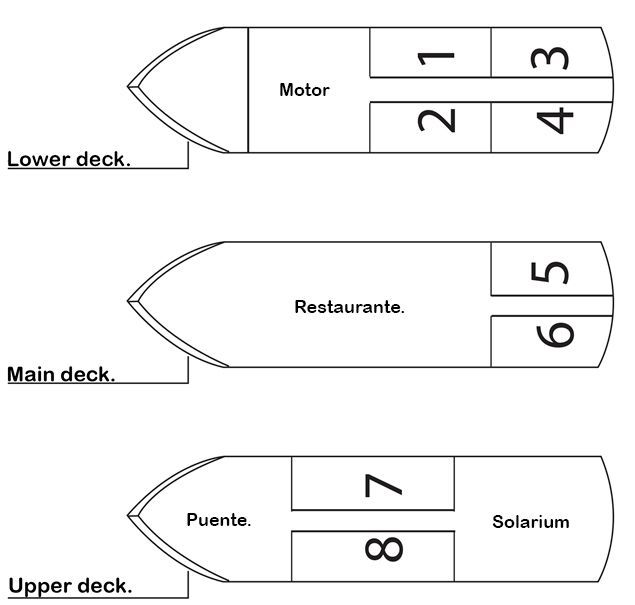
SPECIFICATIONS
Type: Motor Yacht
Lenght: 22.22M
BEAM: 5.09M
Generators: 2 KOHLER 13 KW, 10 KW
Speed: 8 KNOTS NAVIGATION EQUIPMENT
Engines: 2 X 240 H.P. DETROIT DIESEL 8V-71
ITINERARIES
Day 1: Tuesday
Santa Cruz Island
Depart from Guayaquil to Galápagos (1½ hours of flight time).
Baltra Island
This island was a strategic point during the Second World War. It is the main airport for the Galapagos Islands where tourists and colonists arrive and depart. At the Arrival at Baltra Airport, our naturalist English speaking guide will assists you. Transfer to the yacht. Welcome and briefing.
Hacienda Primicias
After lunch, visit Hacienda Primicias to see the giant tortoises in their natural habitat. The tortoises are easy to spot, lumbering around eating grass and leaves and wallowing. Some highland birds, like cattle egrets, mockingbirds, finches or flycatchers can be seen here. After the hike return to the yacht. Dinner and briefing for next day.
Day 2: Wednesday
Tintoreras
After breakfast, Tintoreras is located south of Puerto Villamil. It has a small bay of completely calm turquoise waters, where you can appreciate sea lions, sea turtles, marine iguanas, rays, etc. The bay is connected to a crevice of crystal clear water, that’s shallow and when the tide is low, the entrance closes. In this crevice, you can see how reef sharks swim along with other small fish and sea lions. Lunch on board.
Breeding Center Arnaldo Tupiza
This center has a captive breeding program for tortoises from the populations of southern Isabela.
Humedales
Disembark (dry landing), walk for about 30 mins. This area is characterized by sandy beaches, rocky shores, and mangroves. The area has a number of trails where you can see all four species of mangroves found in Galapagos and also migratory birds: Whimbrel, Short-Billed Dowitcher, Wilson’s Phalarope, Common Tern, Blue-Winged Teal, Osprey, Black-Bellied and Semipalmated Plovers, Greater and Lesser Yellowlegs to name a few.
Wall of tears
By bus to Wall of tears a sad reminder of the history of Isabela. The wall was constructed between 1946 and 1959 while Isabela was a penal colony. As punishment the prisoners were forced to build the wall from huge blocks of lava. The wall is named for the many convicts that died while building the wall. Dinner and briefing for next day.
Day 3: Thursday
Rabida
After breakfast disembark (wet landing) in one of the most colorful and volcanically varied islands in the archipelago as well as a great snorkeling site. We will start on Rabida’s famous maroon sandy beach and after an easy hike (1 km aprox) will arrive to a stunning lookout to enjoy the amazing landscapes.
The island is a birdwatcher’s delight. Some of the rarest species are in abundance, such as nine varieties of finches, Large-billed Flycatchers, Galapagos Hawks and Brown Pelicans. Lunch on board.
Cerron Dragon
After lunch, dry landing at a dock, the walk takes you to a hypersalinic (saltier than the ocean) lagoon behind the beach, often frequented by flamingos, common stilts, pintail ducks and other species of birds. There is a short walk to the hill, which rewards with a great view of the bay and a nesting site of land iguanas. Many of the Iguanas that nest here have been repatriated by the Charles Darwin Research Station. Dinner and briefing for next day.
Day 4: Friday
Black Turtle Cove
After breakfast a dinghy (panga) visit to Black Turtle Bay (Caleta Tortuga Negra). This is very close to Baltra. It is very special due to its lovely beach with sea lions and its clear, calm water. Black (Pacific Green) Turtles and many different types of birds can be seen feeding here as you are paddled around the beautiful lagoons hidden in the mangroves. After this visit transfer to Baltra Airport by bus for your return flight to Guayaquil/Quito
Day 1: Friday
Baltra Island
This island was a strategic point during the Second World War. It is the main airport for the Galapagos Islands where tourists and colonists arrive and depart. At the Arrival at Baltra Airport, our naturalist English speaking guide will assists you. Transfer to the yacht. Welcome and briefing.
Mosquera
After lunch, disembarkation at Mosquera Island (wet landing) located between North Seymour and Baltra. The island consists is a long narrow stretch of white sand, rocks, and tide pools. Created by Geological uplift the island has a flat look to it rather than the conical shape of the volcanically formed islands. It is a great place for snorkeling, strolling on the beach, and enjoying the animal life without the tourist crowds common at many of the more popular islands. This islet is actually home to a huge population of sea lions and is also home to many shorebirds.
Briefing and dinner on board.
Day 2: Saturday
Vicente Roca Point (Isabela Island)
After breakfast, panga ride visit to Vicente Roca Point. Comprised of two separate coves, this site is a large bay with spectacular sea life, observing seahorses, sea turtles, rays, puffer fish, the strange yet fascinating Mola-mola (or sunfish), we see also penguins, blue-footed boobies and nazca boobies. Lunch on board.
Espinoza Point (Fernandina Island)
In the afternoon disembarkation (dry landing). Walk (600m. round trip, 1½h, flat, sandy and rocky path) to see lava flows, a colony of marine iguanas (nesting time: January to June), penguins, pelicans and colonies of cormorants, lava cactus. Time for snorkeling. Briefing and dinner on board.
Day 3: Sunday
Urbina Bay (Isabela Island)
After breakfast, disembarkation at Urbina Bay (wet landing), located in the west of Isabela Island, at the food of the Alcedo volcano. Walk on a sandy and rocky defined path (1 km. round trip. 2h, flat), observing calcareous organisms (shells, corals) exposed above water. In this area we see a large colony of land iguanas, Darwin’s finches, giant tortoises (between June – September) and flightless cormorants. After the hike, time for snorkeling along the shoreline where guests may observe penguins and flightless cormorants.
Tagus Cove (Isabela Island)
After lunch visit to Tagus Cove that was a port where whaling ships arrived and left their ships’ names in a cave in 1800. In the high part is the Darwin Lake, a round salt water crater. Disembark (dry landing). Walk begins from the shore by a wooden stairway that rises to the dusty trail passing through Palo Santo Forest to reach the Darwin Lake. Continue on the trail around the lake through the dry vegetation zone. Panoramic views to the Darwin and Wolf volcanoes. (2kms round trip, 2h / starts at 0m, ascending to 50mts). Later, panga ride through the cliffs to observe the historical graffiti, penguins, flightless cormorants, boobies, pelicans and Sally Lightfoot crabs. Snorkeling time in the cove. Briefing and dinner on board.
Day 4: Monday
Egas Port
Breakfast. The visit to Puerto Egas begins with a wet landing on the dark sand beach of James Bay. Walk along a rocky trail to the salt crater (1.7km. round trip, 1½ h, start at 0m, ascend 30m), observing Darwin Finches, the endemic Galapagos hawks, marine iguanas, sally light root crabs and fur seals and sea lions. Time for swimming and snorkeling.
Sombrero Chino
After lunch, disembark (wet landing) for a short walk of 200m. (30mins. round trip, flat and rocky), observing lava tunnels, lava cactus, Galápagos Sesuvium. Time to swim and snorkel. Return to the yacht. Dinner and briefing for next day.
Day 5: Tuesday
Charles Darwin Research Station (Santa Cruz Island)
After breakfast, walk for about 20 minutes to the Charles Darwin Station, to observe the Galapagos giant turtles breading. T he Darwin Station is part of the Charles Darwin Foundation for the Galápagos Islands, an international non-profit organization dedicated to scientific research in the Galápagos Islands since 1959. After this visit transfer to Baltra Airport by bus for your return flight to Guayaquil.
Day 1: Friday
Baltra Island
Depart from Quito or Guayaquil to Galápagos (1½ hours of flight time). This island was a strategic point during the Second World War. It is the main airport for the Galapagos Islands where tourists and colonists arrive and depart. At the Arrival at Baltra Airport, our naturalist English speaking guide will assists you. Transfer by bus to the dock (5 mins.) to board the yacht. Welcome and briefing.
Bachas Beach
After lunch, disembark (wet landing) in the Bachas Beach, located in the north shore of Santa cruz, this is one of the main nesting sites of sea turtles and the crystal waters invite you to relax and swim. Return to the yacht. Dinner and briefing for next day.
Day 2: Saturday
El Barranco (Genovesa Island)
Also known as Prince Phillip’s Steps, El Barranco’s steep, rocky paths lead up to a high cliff-face. A marvelous view can be appreciated from here. This site is also home to Palo Santo vegetation as well as Red-footed Boobies, Short-eared Lava Owls, Galapagos Swallows storm-petrels and Galapagos Doves. Hiking: 2km., dry landing. Lunch on board.
Darwin Bay
This enormous bay dominates the island and like the Prince Philip’s Steps, this site is the home of large colonies of frigate birds and a wide variety of seabirds. Briefing and dinner on board.
Day 3: Sunday
Bartolome
Lava formations and ash cones can be seen on this Island. A beautiful view of the nearest bays is waiting at the high part, after climbing a wood staircase for 30 to 40 minutes to the top (Walk up to the top of volcano 114 meters, 375 wooden steps). This is one of the most visited Islands because of its unique and famous Pinnacle Rock that consists of an extinct volcano with a variety of red, orange, black and even green volcanic formations. Time for snorkeling and possible sightings of the Galapagos Penguin. Hiking: 2kms. Dry and wet landings.
Sullivan Bay (Santiago Island)
You can swim and snorkel here with seals and penguins. The landing is on a beautiful white sand beach where you will see lava formations. Wet landing. Briefing and dinner on board.
Day 4: Monday
Plazas Island
This small island with steep cliffs was formed by rising lava and is now covered by Opuntia cacti. This Island is home to one of the largest sea lion colonies as well as colorful yellow and red land iguanas. Many birds like the tropicbirds and fork-tailed seagulls rest on the cliffs. The most characteristic plant is the Sesuvium, during the rainy season its color is a greenish to yellowish tone and in the dry season (end of June through January) a bright red. Hike: 2 ½ km. Dry landing. Lunch on board.
Santa Fe
Colonies of sea lions, land iguanas, fork-tailed seagulls, terns and petrels are observed. A trail leading into the heart of the island takes you to a forest of giant cactus and palo santo trees. After this visit on land, you can swim and snorkel. Wet landing. Briefing and dinner on board.
Day 5: Tuesday
Leon Dormido
After breakfast we visit Kicker Rock a giant rock was formed by a volcanic eruption. A narrow canal cuts through it and allows the passage of small boats. This rock is the home of many sea birds and is considered a great snorkeling and diving site. No landing.
Cerro Brujo
This site is located on the north shore of San Cristobal Island. This eroded hill and its surroundings present one of the most picturesque beaches in the Galapagos with its main attraction that is the coral sand beach and its wildlife includes sea turtles, rays, and various types of Booby Birds. Lunch on board.
Lobos Island
The most important colony of sea lions and blue-footed boobies is on this Island. The scenery is beautiful and it is the perfect spot to snorkel. Briefing and dinner on board. Return to the yacht. Dinner and briefing for next day.
Day 6: Wednesday
Suarez Point
Breakfast. This natural is home for see blue-footed boobies, masked boobies, colonies of marine iguanas, fascinating albatross from April to June, sea lions, Galapagos doves and Darwin finches. There is another natural attraction: the lava blowhole, spurting water high into the air. Hike: 3km. Dry landing. Lunch on board.
Gardner Bay
On the eastern side of the island, is the breeding site of nearly all of the world´s 12,000 pairs of Waved Albatrosses. It takes 45 minutes by boat to reach this site. . The white sand beach is home to a group of sea lions. Swimming and snorkeling are excellent possibilities here. Wet landing .
Gardner Islet
Sea lions, marine turtles and finches can be seen here.
Osborn Islet
This small island to the southeast of Española is a marine visit for snorkeling and swimming. Dinner and briefing for next day.
Day 7: Thursday
Cormorant Point
Breakfast. This site hosts a large flamingo lagoon where other birds such as common stilts, White-cheeked Pintails can also be seen. Olivine crystals in the beach make to name as the Green Beach. To the other side of the island, there is very fine white sand beach where marine turtles nest from December to May. Hike: 2km. Wet landing.
Devil´s Crown
This volcanic crater has been eroded by the waves leaving the northern and southern sides poking out of the water. The coral formations make the underwater scenery impressive for snorkelers where there are schools of multi-colored fish, sharks and sea turtles. No Landing.
Charles Darwin Station
The Darwin Station is part of the Charles Darwin Foundation for the Galápagos Islands, an international non-profit organization dedicated to scientific research in the Galápagos Islands since 1959. This visit offers an excellent introduction to the Islands, their origin and their formation. Learn about the Galapagos giant turtles breeding. Dinner and briefing for next day.
Day 8: Friday
North Seymour
This Island is known for its large number of blue-footed boobies, colonies of magnificent frigate birds, fork-tailed seagulls, marine iguanas and sea lions. The island is characterized by its arid vegetation zone, been palo santo (holy wood) the most remarkable tree in this island. Wet landing.
Day 1: Friday
Baltra Island
This island was a strategic point during the Second World War. It is the main airport for the Galapagos Islands where tourists and colonists arrive and depart. At the Arrival at Baltra Airport, our naturalist English speaking guide will assists you. Transfer to the yacht. Welcome and briefing.
Mosquera
After lunch, disembarkation at Mosquera Island (wet landing) located between North Seymour and Baltra. The island consists is a long narrow stretch of white sand, rocks, and tide pools. Created by Geological uplift the island has a flat look to it rather than the conical shape of the volcanically formed islands. It is a great place for snorkeling, strolling on the beach, and enjoying the animal life without the tourist crowds common at many of the more popular islands.. This islet is actually home to a huge population of sea lions and is also home to many shorebirds. Briefing and dinner on board.
Day 2: Saturday
Vicente Roca Point (Isabela Island)
After breakfast, panga ride visit to Vicente Roca Point. Comprised of two separate coves, this site is a large bay with spectacular sea life, observing seahorses, sea turtles, rays, puffer fish, the strange yet fascinating Mola-mola (or sunfish), we see also penguins, blue-footed boobies and nazca boobies. Lunch on board.
Espinoza Point (Fernandina Island)
In the afternoon disembarkation (dry landing). Walk (600m. round trip, 1½h, flat, sandy and rocky path) to see lava flows, a colony of marine iguanas (nesting time: January to June), penguins, pelicans and colonies of cormorants, lava cactus. Time for snorkeling. Briefing and dinner on board.
Day 3: Sunday
Urbina Bay (Isabela Island)
After breakfast, disembarkation at Urbina Bay (wet landing), located in the west of Isabela Island, at the food of the Alcedo volcano. Walk on a sandy and rocky defined path (1 km. round trip. 2h, flat), observing calcareous organisms (shells, corals) exposed above water. In this area we see a large colony of land iguanas, Darwin’s finches, giant tortoises (between June – September) and flightless cormorants. After the hike, time for snorkeling along the shoreline where guests may observe penguins and flightless cormorants.
Tagus Cove (Isabela Island)
After lunch visit to Tagus Cove that was a port where whaling ships arrived and left their ships’ names in a cave in 1800. In the high part is the Darwin Lake, a round salt water crater. Disembark (dry landing). Walk begins from the shore by a wooden stairway that rises to the dusty trail passing through Palo Santo Forest to reach the Darwin Lake. Continue on the trail around the lake through the dry vegetation zone. Panoramic views to the Darwin and Wolf volcanoes. (2kms round trip, 2h / starts at 0m, ascending to 50mts). Later, panga ride through the cliffs to observe the historical graffiti, penguins, flightless cormorants, boobies, pelicans and Sally Lightfoot crabs. Snorkeling time in the cove. Briefing and dinner on board.
Day 4: Monday
Egas Port
Breakfast. The visit to Puerto Egas begins with a wet landing on the dark sand beach of James Bay. Walk along a rocky trail to the salt crater (1.7km. round trip, 1½ h, start at 0m, ascend 30m), observing Darwin Finches, the endemic Galapagos hawks, marine iguanas, sally light root crabs and fur seals and sea lions. Time for swimming and snorkeling.
Sombrero Chino
After lunch, disembark (wet landing) for a short walk of 200m. (30mins. round trip, flat and rocky), observing lava tunnels, lava cactus, Galápagos Sesuvium. Time to swim and snorkel. Return to the yacht. Dinner and briefing for next day.
Day 5: Tuesday
Charles Darwin Research Station (Santa Cruz Island)
After breakfast, walk for about 20 minutes to the Charles Darwin Station, to observe the Galapagos turtles breading. The Darwin Station is part of the Charles Darwin Foundation for the Galápagos Islands, an international non-profit organization dedicated to scientific research in the Galápagos Islands since 1959.
Hacienda Primicias
After lunch, visit to Hacienda Primicias to see the giant tortoises in their natural habitat. The tortoises are easy to spot, lumbering around eating grass and leaves and wallowing. Some highland birds, like cattle egrets, mockingbirds, finches or flycatchers can be seen here. After the hike return to the yacht. Dinner and briefing for next day.
Day 6: Wednesday
Tintoreras
After breakfast, Las Tintoreras is located south of Puerto Villamil. It has a small bay of completely calm turquoise waters, where you can appreciate sea lions, sea turtles, marine iguanas, rays, etc. The bay is connected to a crevice of crystal clear water, that’s shallow and when the tide is low, the entrance closes. In this crevice, you can see how reef sharks swim along with other small fish and sea lions. Lunch on board.
Breeding Center Arnaldo Tupiza
This center has a captive breeding program for tortoises from the populations of southern Isabela.
Humedales
Disembark (dry landing), walk for about 30 mins. This area is characterized by sandy beaches, rocky shores, and mangroves. The area has a number of trails where you can see all four species of mangroves found in Galapagos and also migratory birds: Whimbrel, Short-Billed Dowitcher, Wilson’s Phalarope, Common Tern, Blue-Winged Teal, Osprey, Black-Bellied and Semipalmated Plovers, Greater and Lesser Yellowlegs to name a few.
Wall of tears
By bus to Wall of tears a sad reminder of the history of Isabela. The wall was constructed between 1946 and 1959 while Isabela was a penal colony. As punishment the prisoners were forced to build the wall from huge blocks of lava. The wall is named for the many convicts that died while building the wall. Dinner and briefing for next day.
Day 7: Thursday
Rabida
After breakfast disembark (wet landing) in one of the most colorful and volcanically varied islands in the archipelago as well as a great snorkeling site. We will start on Rabida’s famous maroon sandy beach and after an easy hike (1 km aprox) will arrive to a stunning lookout to enjoy the amazing landscapes. The island is a birdwatcher’s delight. Some of the rarest species are in abundance, such as nine varieties of finches, Large-billed Flycatchers, Galapagos Hawks and Brown Pelicans.
Cerro Dragon
After lunch, dry landing at a dock, the walk takes you to a hypersalinic (saltier than the ocean) lagoon behind the beach, often frequented by flamingos, common stilts, pintail ducks and other species of birds. There is a short walk to the hill, which rewards with a great view of the bay and a nesting site of land iguanas. Many of the Iguanas that nest here have been repatriated by the Charles Darwin Research Station. Dinner and briefing for next day.
Day 8: Friday
Black Turtle Cove
After breakfast a dinghy (panga) visit to Black Turtle Bay (Caleta Tortuga Negra). This is very close to Baltra. It is very special due to its lovely beach with sea lions and its clear, calm water. Black (Pacific Green) Turtles and many different types of birds can be seen feeding here as you are paddled around the beautiful lagoons hidden in the mangroves. After this visit transfer to Baltra Airport by bus for your return flight to Guayaquil/Quito.
Day 1: Monday
Baltra Island
This island was a strategic point during the Second World War. It is the main airport for the Galapagos Islands where tourists and colonists arrive and depart. At the Arrival at Baltra Airport, our naturalist english speaking guide will assists you. Transfer to the hotel. Welcome and briefing.
Tortuga Bay Beach
After lunch, visit to Tortuga Bay Beach a pristine location covered with beautiful white sand beach. It takes around an hour walk to get the beach. Beautiful birds including the famous Galapagos Finches can be admired. The trail to the beach is paved and marked. There are two beaches at Tortuga Bay, the main beach is used for surfing due to its strong waves. There is a site where sea is calm. After this visit you can enjoy the attractions of the night-life offered by the Island. Accommodation and dinner at Hotel Fernandina or similar.
Day 2: Tuesday
Charles Darwin Research Station
After breakfast, walk for about 20 mins. to the Charles Darwin Station, to observe the Galapagos Giant Turtles breading. The Darwin Station is part of the Charles Darwin Foundation for the Galápagos Islands, an international non-profit organization dedicated to scientific research in the Galápagos Islands since 1959.
Hacienda Primicias
After lunch, visit to Hacienda Primicias to see the Giant Tortoises in their natural habitat. The Tortoises are easy to spot, lumbering around eating grass and leaves and wallowing. Some highland Birds, like Cattle Egrets, Mockingbirds, Finches or Flycatchers can be seen here. After the hike return to the yacht. Dinner and briefing for next day.
Day 3: Wednesday
Tintoreras
After breakfast, Tintoreras is located south of Puerto Villamil. It has a small bay of completely calm Turquoise waters, where you can appreciate Sea Lions, Sea Turtles, Marine Iguanas, Rays, etc. The bay is connected to a crevice of crystal clear water, that’s shallow and when the tide is low, the entrance closes. In this crevice, you can see how Reef Sharks swim along with other small fish and Sea Lions. Lunch on board.
Breeding Center Arnaldo Tupiza
This center has a captive breeding program for Tortoises from the populations of southern Isabela.
Humedales
Disembark (dry landing), walk for about 30 mins. This area is characterized by sandy beaches, rocky shores, and mangroves. The area has a number of trails where you can see all four species of mangroves found in Galapagos and also migratory birds: Whimbrel, Short-billed Dowitcher, Wilson’s Phalarope, Common Tern, Blue-winged Teal, Osprey, Black-bellied and Semipalmated Plovers, Greater and Lesser Yellowlegs to name a few.
Wall of tears
By bus to Wall of tears a sad reminder of the history of Isabela. The wall was constructed between 1946 and 1959 while Isabela was a penal colony. As punishment the prisoners were forced to build the wall from huge blocks of lava. The wall is named for the many convicts that died while building the wall. Dinner and briefing for next day.
Day 4: Thursday
Rabida
After breakfast disembark (wet landing) in one of the most colorful and volcanically varied islands in the archipelago as well as a great snorkeling site. We will start on Rabida’s famous maroon sandy beach and after an easy hike (1 km aprox) will arrive to a stunning lookout to enjoy the amazing landscapes.
The island is a birdwatcher’s delight. Some of the rarest species are in abundance, such as nine varieties of Finches, Large-billed Flycatchers, Galapagos Hawks and Brown Pelicans.
Cerro Dragon
After lunch, dry landing at a deck, the walk takes you to a hypersalinic (saltier than the ocean) lagoon behind the beach, often frequented by Flamingos, Common Stilts, Pintail Ducks and other species of birds. There is a short walk to the hill, which rewards with a great view of the bay and a resting site of land Iguanas. Many of the Iguanas that rest here have been repatriated by the Charles Darwin Research Station. Dinner and briefing for next day.
Day 5: Friday
Black Turtle Cove
After breakfast a dinghy (panga) visit to Black Turtle Bay (Caleta Tortuga Negra). This is very close to Baltra. It is very special due to its lovely beach with Sea Lions and its clear, calm water. Black (Pacific Green) Turtles and many different types of birds can be seen feeding here as you are paddled around the beautiful lagoons hidden in the mangroves. After this visit transfer to Baltra Airport by bus for your return flight to Guayaquil/Quito
DISCOUNTS APPLY, PLEASE CONTACT US
|
PROGRAM |
FIT´S |
CHARTER |
|
4 days/días – 3 nights/noches |
1.345 |
21.520 |
|
5 days/días – 4 nights/noches |
1.672 |
26.752 |
|
8 days/días – 7 nights/noches |
2.658 |
42.528 |
|
12 days/días – 11 nights/noches |
3.975 |
63.600 |
|
15 days/días – 14 nights/noches |
5.290 |
84.640 |
CONDITIONS:
– In the event that the national government orders the increase in inputs or the mandatory collection of Value Added Tax and our costs are affected, the rates will be subject to readjustment.
– Supplement for SUPERIOR cabins in the two boats: USD 100 net per person of the net rate.
SUPERIOR CABINS ARE:
Y/Golondrina = 2 cabins on MAINDECK and 2 cabins on UPPERDECK with bunk beds.
– Supplement for guide in another language should be consulted.
– Supplement for single cabin 80%
– A 10% discount will be applied for children from 0 to 5 years old after checking availability and season.
– Surcharge of $150.00 usd per pax for Christmas and New Year.
RATES INCLUDE:
– All meals while the tour takes place.
– Bilingual naturalist guide (English-Spanish).
– All excursions and visits detailed in the program (subject to change in case of force majeure)
– Snacks after visits.
– Drinking water, tea, coffee.
NOT INCLUDE:
– Air ticket to/from Galapagos USD 530 net per person**
If passengers decide to book their own air tickets and this causes delays and extra expenses are incurred (boats, buses, hotel, etc.) in order to join the cruise on the first day AND/or on the last day to catch their return flight, they must assume full responsibility and cover your expenses, also our yachts will not modify their itineraries due to that cause.
– Entrance to the Galapagos National Park USD 100 per person **
– INGALA migratory transit control card USD 20 per person **
– Snorkeling equipment: 5 days: USD 25 per person – 8 days: USD 35 per person**
– Wetsuit : 5 days: USD 25 per person – 8 days: USD 35 per person**
– Tips and other unspecified expenses.
(**Rates subject to change without notice)

 Русский
Русский